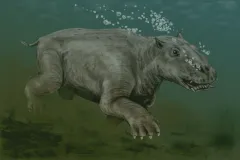Flippers or Feet? An Extinct Mammal May Have Been Replaced By Today's Sea Cows

In the seagrass beds and kelp forests of the Oligocene-Miocene transition, nearly 32.5 to 10.5 million years ago, a four-legged, gnarly-toothed mammal roamed the Northern Pacific shores of what is now Japan, Canada and the United States. This mammal, part of the order Desmostylia, straddled the marine and terrestrial environments much like seals and sea lions of today, but with feet instead of flippers.
The Desmostylia are the only order of marine mammals to entirely go extinct, and a new paper published in Biology Letters provides evidence that competition with other kelp-grazing mammals may have been the culprit.
Often compared to a hippopotamus, Desmostylia were more closely related to elephants and the Sirenia order, a group that includes the manatees, sea cows and dugongs. The sirenians appear in the fossil record in the middle of the Miocene, roughly 30 million years after the appearance of the first Desmostylia at the onset of the Oligocene. Sirenians and Desmostylia were both herbivorous mammals that lived in shallow waters where they fed on seagrass and kelp, but the Desmostylia employed a markedly different style of eating. Ounalashkastylus tomidai, a Desmostylia species found off of Alaska’s Aleutian Islands, vacuumed their food from the seafloor, uprooting seagrass entirely. This suction eating method is unique among herbivorous marine mammals that typically rip and chew vegetation but leave the base attached.
As desmostylians disappear from the fossil record the sirenians gain prominence as the sole herbivorous marine mammal.
“That’s kinda cool, no one has ever shown that,” says Nicholas Pyenson, Curator of Fossil Marine Mammals at the Smithsonian National Museum of Natural History and coauthor of the new study.

Two skulls belonging to extinct herbivorous mammals from the late Oligocene. Left, the skull of Cornwallius, a completely extinct type of herbivorous marine mammal called a desmostylian, which lived only in the North Pacific Ocean. Right, the skull of an extinct dugong relative, Callistosiren, which lived in the Caribbean. Photo: A. Boersma.
The discovery was just a small part of a larger investigation into the rise of marine mammal gigantism. While baleen whale size skyrocketed in recent geological time, herbivorous marine mammals failed to follow suit. The ancestors of sea cows, dugongs and manatees, as well as the Desmostylia, maintained fairly stable sizes over the same time period.
Pyenson’s study compared herbivorous mammals in the Pacific and Atlantic basins, showing that herbivorous mammals in the Pacific attained body sizes roughly twice those of their counterparts in the Atlantic. Why might this distinct trend occur?
Though kelp and seagrass are both food for herbivores, Pacific kelp grow like weeds when compared to Atlantic seagrasses, and so can feed much larger consumers, even in the face of heavy grazing. The Pacific Steller’s sea cow reached sizes of 33 feet long and weighed up to 5,500 tons and probably fed on kelp, though very little is known about this docile giant since it disappeared due to hunting only 27 years after its discovery in 1741. The manatees of the Atlantic only reach lengths up to 13 feet.

A dugong grazes on seagrass in the Red Sea. The scars on its back are most likely boat propeller scars. Photo credit: Mark Goodchild, Flickr
Recent human expansion near manatee and dugong habitats threatens them with the fate of the Desmostylia. The IUCN Red List of Threatened Species currently lists all manatee and dugong species as vulnerable to extinction. The gentle sea cows eat along popular boating routes and often get in the way of fast-moving boats and their propellers. They are also vulnerable to red tides, habitat destruction and hunting. Fortunately, some changes, such as reducing boat speeds in manatee habitats, are protecting manatees against human threats, and Atlantic manatee numbers have recently increased in some places. It would be a tragedy if due to our actions these gentle giants only existed in memory and the fossil record.

